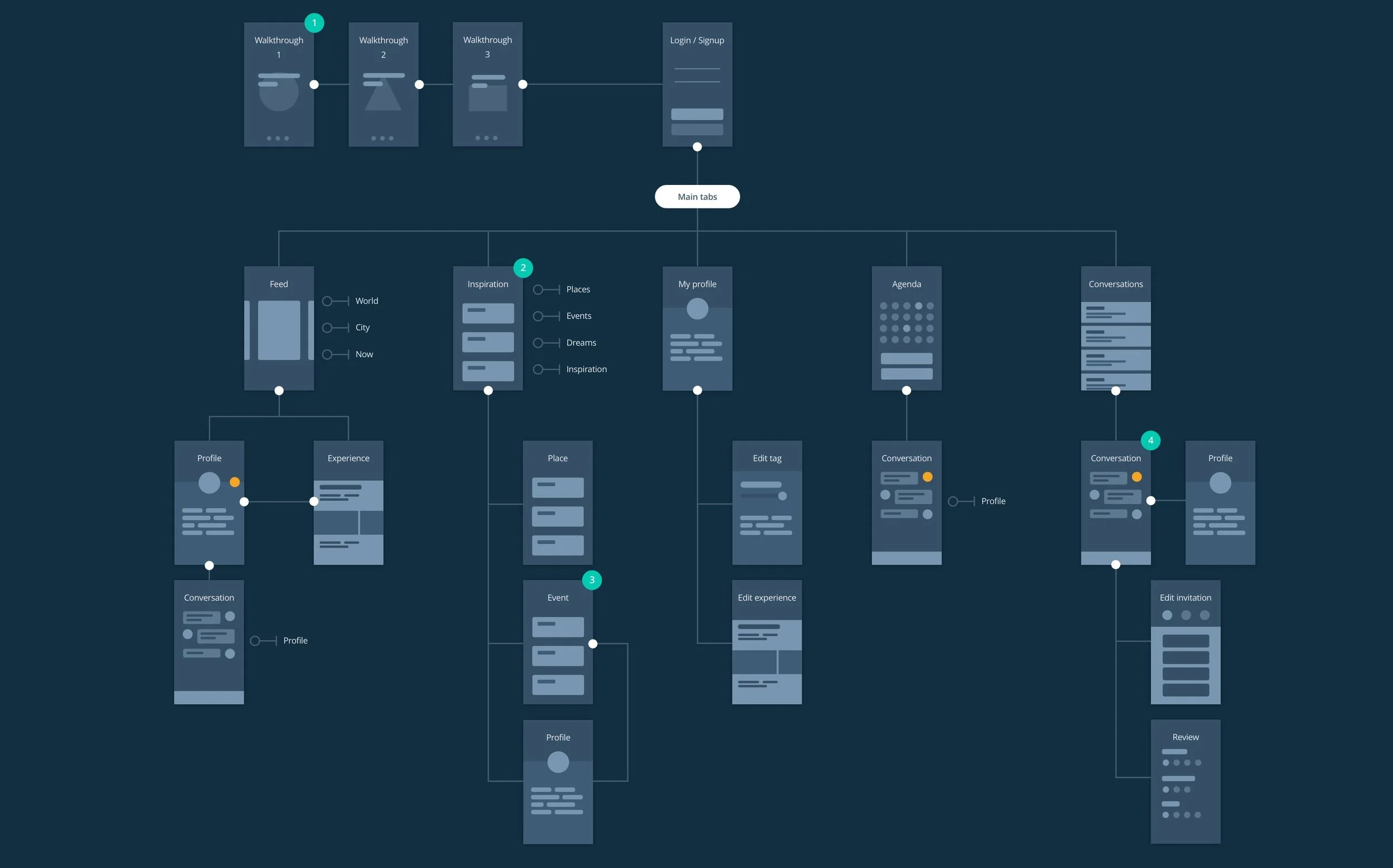
Wandernaut
User Research, UX/UI Design — 2016-2019
Wandernaut was an attempt to help creative communities develop by connecting the right people together through meaningful face-to-face conversations.
User research
The method
The success of Wandernaut highly depends on the users’ perception of each other, therefore it was crucial to collect as much information as possible about the user’s attitudes and behaviors. Qualitative research through interviews was the ideal method for that. Given that the target audience of the app are those who seek to have conversations with strangers, interviews were conducted with users of platforms like Meetup, E-180 and Shapr. Interviewees were questioned on their attitudes toward strangers, how they currently expand their social and professional network and how they find inspiration in their life.
After analyzing the answers and defining the jobs-to-be-done, new questions came up about the persona and a follow-up Typeform survey was sent through Facebook.
The insights
The persona’s core problems
They want to grow their social network, but find it hard to meet people outside their existing network
Permission. When in need of inspiration, their preferred method is to engage in a conversation, but they often find it awkward to talk to strangers because there’s a constant fear of interrupting someone’s work
Attitudes and behaviors
They are spontaneous, there’s a desire to take action right when the inspiration comes
They are inspired by seeing what the other is passionate about (preferably in a visual way), the projects they work on and the range of their interests.
When they travel, meeting interesting people is always one of the main goals
They often feel both excitement and awkwardness in the first moments of a conversation

Ideation
After exploring many possible solutions, the three most promising approaches were presented to users and the final one was selected based on this feedback.
A.
The user browses by interest, and can start an audio conversation with a stranger spontaneously within 1-2 minutes.
B.
The user browses by interest and can plan video conversations with strangers for a future moment.
C.
The user browses by interest and can plan video conversations with strangers for a future moment.
Chosen solution : C
The profile-first solution was prefered to the interest-first ones, primarily because the people we interviewed mentioned they are more flexible on the topic of conversation when the profile they are looking at seems interesting, whereas the opposite isn’t true. We also created a design that combines both the spontaneous and the planned mode for conversations into a seamless experience.

App architecture
After figuring out how the core user problems could be addressed, I started building the structure that could support the user stories. I ended up separating the experience in five main tabs : the feed (containing the profiles and experiences), inspiration, my profile, the agenda and the conversations. This separation gives easy access to the most important and frequent user stories : browsing profiles, getting inspired, editing interests, viewing upcoming meetings and responding to a message.
InVision prototype

User experience
The challenge
The persona has 4 different user stories in terms of meeting people, based on their constraint or flexibility on time and location.
The solution
World
Browse profiles around the world to plan a video chat.
Nearby
Browse profiles in your city, for a meeting or a video chat.
Now
Set the time until which you’re available, whether you’re available in person and/or by video chat and start browsing people who are available right now as well. Get notified when more people are available.
Creating four menu tabs isn’t a viable solution because the user can be in two user stories at once, which would force them to change tabs constantly.
The challenge
When planning a meeting, the activity, time and location are often confirmed at different moments (e.g. the user wants to agree on a coffee, but doesn’t know where yet).
The solution
The activity, time and location suggestions can be sent independently or all at once. A partial invitation can then be accepted and updated later if required. This allows users to agree much more easily on meeting each other even though the details haven’t been sorted out.
The need
In the interviews we understood that what truly inspires the persona is knowing what another person is working on in a concrete way – their projects. This allows them to engage in an interesting conversation right away and opens the door to asking meaningful questions about the person’s motivations and process on that project.
The solution
Using this insight, I designed a “projects” element for profiles where users can showcase their work. After presenting the mocks for feedback again, we received a positive response and thought about how this new element would work in the product.
Not only this can help users find a good match, but we also included projects in the future vision of the product, making it possible to browse projects across the whole community to find something they could collaborate on based on their interests.

UI design
Profile
The profile is the most important design element in Wandernaut because it influences the user’s perception of other people. Over 30 variations of the layout were created and iterated through user feedback. This layout was finally picked as the most inspiring one for the user.
In-line editing is also used, allowing the user to see his profile almost exactly like others users would.

Conversations
The lines between the UX and UI design work begin to be blurred when the balance between function and visual attractiveness is hard to achieve. The invitation module at the top forced me to generate many unintuitive ideas and a working solution was finally found after trying about 15 alternatives.











